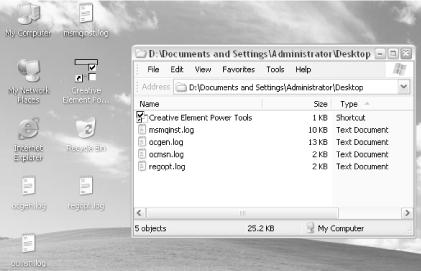Name
Desktop
Synopsis
The Desktop is the basis for the modern GUI paradigm. The Desktop is considered a container for all other resources on your computer, as well as a backdrop for your Windows workspace. The Desktop is always underneath any open windows—to access the Desktop if it’s covered, you need to minimize or close any open windows (press the Windows logo key and D, or right-click on the Taskbar and select Minimize All Windows to accomplish this quickly).
As shown in Figure 3-7, the Desktop contains two types of icons; namespace icons and file icons.

Figure 3-9. Of the icons shown on the Desktop, some are virtual objects and some are files; those that are actual files are also shown in your Desktop folder
File icons can be files or
folders (actually located in your
\Documents
and
Settings\{username}\Desktop\ folder on your hard
disk)—you can drag-drop them to and from the Desktop as though
it were any other ordinary folder. The Desktop is a good place to
store newly downloaded files from the Internet, email attachments,
items from floppies, and other files you’re
currently working on.
Namespace icons, on the other hand, such as My Computer, My Network Places, and the Recycle Bin, aren’t files, but rather specific resources built in to Windows. All of these icons can be renamed or even hidden, although the process isn’t always obvious. (See Chapter 5 for details specific to ...
Get Windows XP in a Nutshell, Second Edition now with the O’Reilly learning platform.
O’Reilly members experience books, live events, courses curated by job role, and more from O’Reilly and nearly 200 top publishers.

